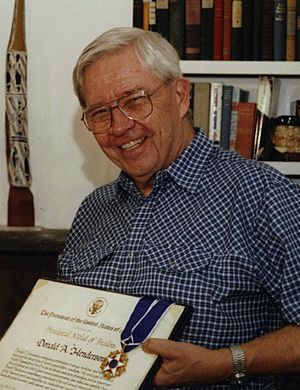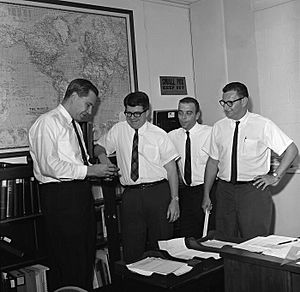Donald Henderson facts for kids
Quick facts for kids
Donald Henderson
|
|
|---|---|

Henderson with his Presidential Medal of Freedom in July 2002
|
|
| Born |
Donald Ainslie Henderson
September 7, 1928 |
| Died | August 19, 2016 (aged 87) |
| Nationality | American |
| Alma mater | University of Rochester |
| Known for | Eradicating smallpox |
| Awards | Ernst Jung Prize (1976) Public Welfare Medal (1978) National Medal of Science (1986) Japan Prize (1988) Albert B. Sabin Gold Medal (1994) Calderone Prize (1999) Presidential Medal of Freedom (2002) |
| Scientific career | |
| Fields | Epidemiology |
| Institutions | World Health Organization Johns Hopkins University University of Pittsburgh UPMC Center for Health Security |
Donald Ainslie Henderson (born September 7, 1928 – died August 19, 2016) was an American doctor and scientist. He was an epidemiologist, which means he studied how diseases spread and how to control them.
Dr. Henderson led a huge 10-year project from 1967 to 1977. This project successfully got rid of smallpox all over the world. He also helped start programs to vaccinate children around the globe.
After this amazing achievement, he became the Dean of the Johns Hopkins School of Public Health from 1977 to 1990. Later in his career, he worked on making sure the United States was ready for public health emergencies, like disease outbreaks or natural disasters.
Contents
Early Life and Education
Donald Henderson was born in Lakewood, Ohio, on September 7, 1928. His parents were immigrants from Scotland and Canada. His father, David Henderson, was an engineer, and his mother, Eleanor McMillan, was a nurse.
Donald became interested in medicine because of his uncle, William McMillan. His uncle was a doctor in Canada and also a member of the Canadian Parliament.
Henderson went to Oberlin College and graduated in 1950. He then earned his medical degree (MD) from the University of Rochester School of Medicine in 1954. He worked as a resident doctor at the Mary Imogene Bassett Hospital.
Later, he joined the Epidemic Intelligence Service at the Communicable Disease Center (now called the Centers for Disease Control and Prevention, or CDC). In 1960, he earned another degree, a Master of Public Health (MPH), from the Johns Hopkins School of Hygiene and Public Health.
Fighting Diseases: Smallpox Eradication
From 1960 to 1965, Dr. Henderson was in charge of the CDC's programs that watched for virus diseases. He worked closely with another epidemiologist named Alexander Langmuir.
During this time, he and his team came up with a plan. It was a program to get rid of smallpox and control measles in 18 countries in western and central Africa. This project started in 1967.
This African project helped kick off an even bigger plan by the World Health Organization (WHO). The WHO wanted to wipe out smallpox across the entire world within 10 years. In 1966, Dr. Henderson moved to Geneva, Switzerland, to lead this global campaign.
At that time, smallpox was a huge problem. It was found in Brazil and 30 countries in Africa and South Asia. More than 10 million people got sick and 2 million died each year from smallpox.
Vaccinations helped, but the main plan was called "surveillance-containment." This meant that doctors and health workers quickly reported any new cases of smallpox. Then, they would quickly vaccinate everyone who lived with or had close contact with the sick person.
WHO staff and advisors from 73 countries worked together with local health teams. The very last case of smallpox happened in Somalia on October 26, 1977. This was just 10 years after the program began!
Three years later, the World Health Assembly announced that smallpox vaccination was no longer needed. Smallpox is the first human disease ever to be completely wiped out. This success inspired the WHO to start other global vaccination programs. These programs targeted diseases like polio, measles, tetanus, diphtheria, and whooping cough.
Later Career and Public Health Safety
From 1977 to 1990, Dr. Henderson was the Dean of the Johns Hopkins School of Public Health. In 1986, he received the National Medal of Science for his work leading the smallpox campaign.
He later worked for the US government, helping with science policy and public health. In 1998, he started the Johns Hopkins Center for Civilian Biodefense Strategies. This center focused on protecting people from biological attacks.
After the attacks on September 11, 2001, Dr. Henderson was asked to lead the Office of Public Health Preparedness. This office was in charge of making sure the country was ready for public health emergencies. Congress gave $3 billion to help with this important work.
Dr. Henderson also wrote academic papers. In 2006, he wrote about "social distancing" during a pandemic. He said it could cause big problems for communities and the economy.
Until his death, he was the Editor Emeritus of a journal called Health Security.
Awards and Recognition
Dr. Henderson received many important awards for his work. Some of these include:
- 1978 – Public Welfare Medal
- 1986 – National Medal of Science
- 1988 – The Japan Prize
- 2002 – Presidential Medal of Freedom (the highest civilian award in the United States)
Seventeen universities also gave him honorary degrees.
Personal Life
Donald Henderson married Nana Irene Bragg in 1951. They had a daughter and two sons. They lived in Atlanta, Georgia, and Geneva, Switzerland.
He passed away at the age of 87 in Towson, Maryland, after fracturing his hip.


